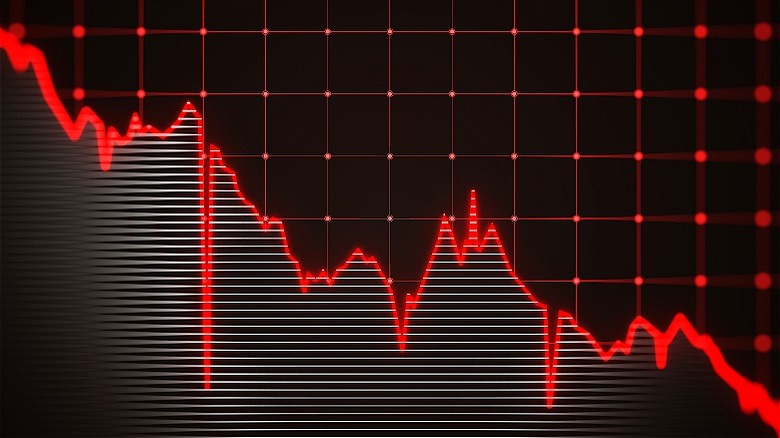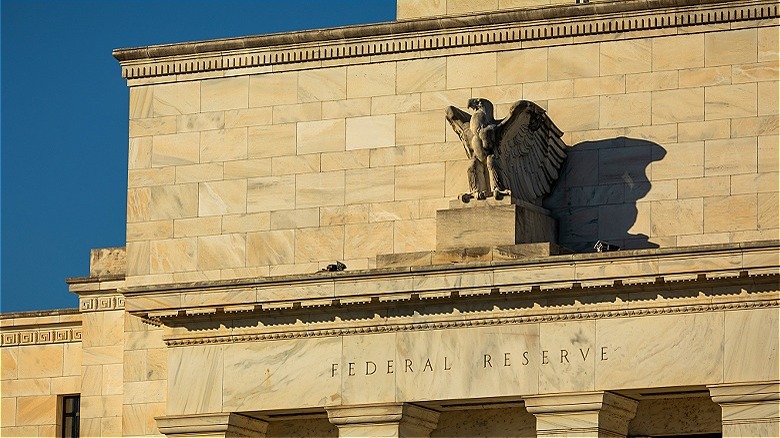The Worst Day In The History Of The Stock Market
The post-pandemic bumpiness of the stock market has put many investors on edge. In fact, the 2022 end-of-year index numbers were the worst since the 2008 financial crisis. Even worse for investors, the S&P market cap declined by $8 billion. While the market has reached a kind of equilibrium since then, January 2024 stock market behavior was still rocky, with all three indexes declining in the first week of the new year. While this volatility can be difficult for anyone who actively invests, or those with 401(k) plans wrapped up in investments, it's by no means unprecedented. The stock market has faced more than a few downturns, and while it might be financially difficult to live through today, history has some much worse financial examples to offer.
Many people might mistakenly assume that the Wall Street stock market crash of October 28, 1929, is the worst day in the history of the stock market; however, they would technically be wrong. While 1929's Black Monday undoubtedly started a chain reaction that sent the United States into the Great Depression, the full impact was the result of weeks and even months of steady decline. For example, on 1929's Black Monday, the Dow declined by nearly 13%, which is roughly the same as it declined in March 2020 at the beginning of the COVID-19 pandemic. However, unlike in 2020, 1929's Black Monday became the beginning of a long series of losses that would keep the Dow from hitting its pre-crash height again until November 1954.
The worst single day for US stocks
While there's no downplaying the significance and impact of 1929's Black Monday, its single-day Dow drop does not properly convey its overall financial impact. Plus, the 13% drop in 1929's Black Monday pales in comparison to the worst single-day stock market drop in U.S. history. Yet another Black Monday, this time on October 19, 1987, saw the Dow plunge almost 22% in a single day. This rapid drop holds the distinction as the biggest single-day decline in stock market history. Similar to its 1929 predecessor, this Black Monday led to further shockwaves, with the major stock indexes having lost 20% of their value by the end of October 1987.
However, what distinguishes this particular stock market drop compared to others is that there was no singular economic problem that led to it. This is also, coincidentally, what allowed the market to recover fairly fast as opposed to the 1929 crash. In fact, the Dow Jones began rebounding within a few weeks and officially recouped all of its losses by September 1989.
As for what caused the stock market to crash in the fall of 1987 in the first place, many smaller factors helped contribute to the crash, ranging from the U.S.'s trade deficit to rising tensions in the Middle East. However, perhaps the biggest factor that directly contributed to this particular crash was the introduction and growth of modern computerized trading. Since much of this trading is purely automated (known as programmatic trading), a flood of computer-originated sell orders caused other investors to similarly panic sell.
Other notable days in stock market history
Not every crash hits the same single-day drops as 1929 or 1987, but that doesn't mean they aren't financially significant. Notably, the dot-com bubble busting had a long-reaching impact during the early 2000s. In fact, the tech-heavy Nasdaq didn't hit its 2001 peak again for another 15 years after the crash. The dot-com crash was mainly rooted in an overvaluation of stocks, especially internet stocks. Investors poured money into the internet sector with the speculative expectation that these dot-com companies would become profitable. However, the fervor over dot-com companies heated up the economy in a dangerous way. The Federal Reserve attempted to slow down the economy then by raising the federal funds rate six times between mid-1999 and mid-2000 but the effort was too late.
The 2008 housing crisis was another notable, and more recent, stock market crash. In the post-dot -com bubble economy, the Fed dropped interest rates to as low as 1% — encouraging Americans to take out adjustable-rate mortgages rather than the more traditional fixed-rate mortgages. Homebuyers who chose adjustable-rate mortgages nearly doubled in 2004 alone, which set the stage for problems once the Fed began raising the federal funds rate. These rate increases, and the variable rate increases given to mortgage holders who were not creditworthy, led to massive increases in monthly mortgage payments, causing many of them to default. By September 2008, stock indexes lost almost 20% of their value. The Dow hit its lowest point in 2009 (6,469.95), and it would take four years for it to recover while the United States economy suffered through a recession.


